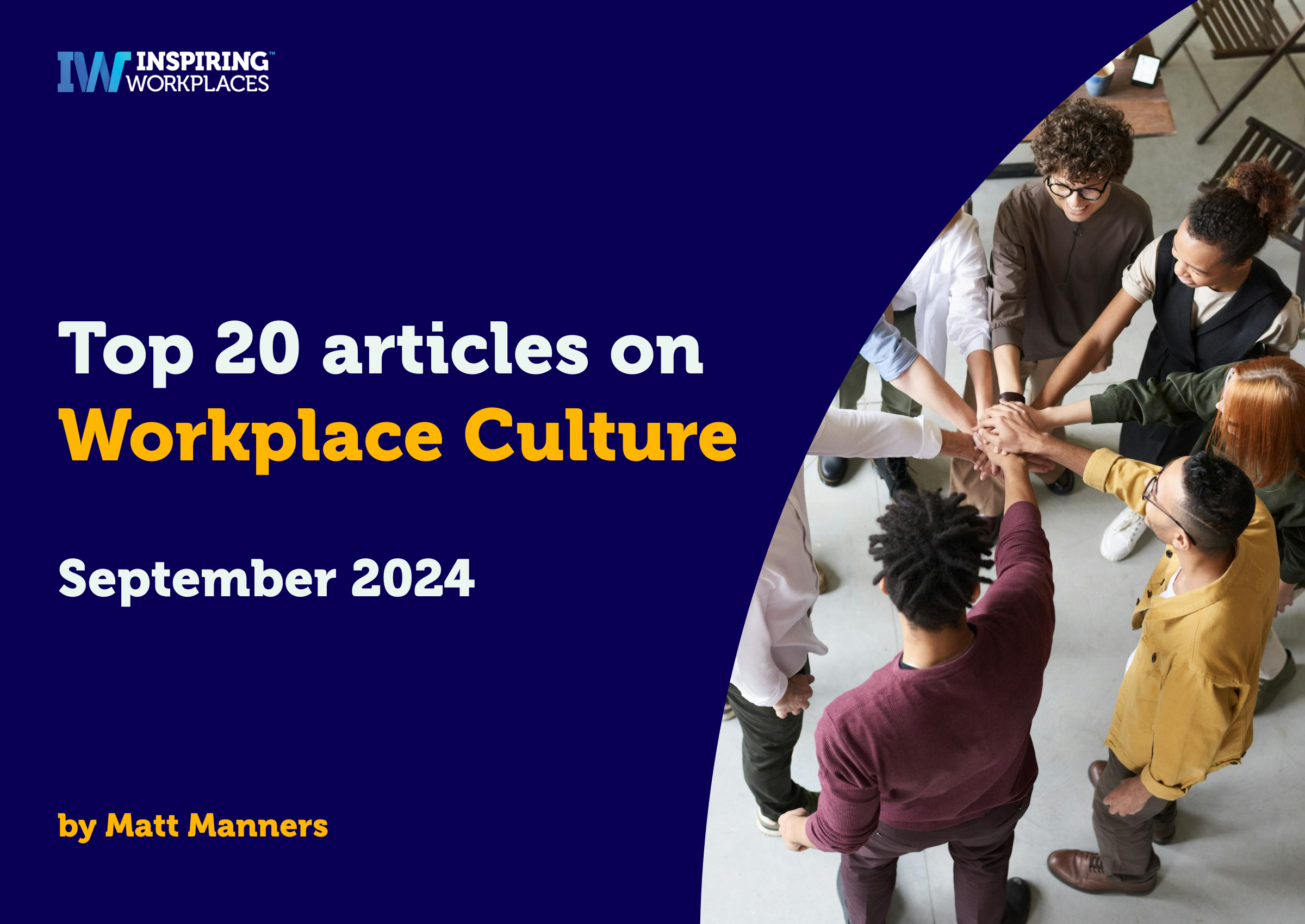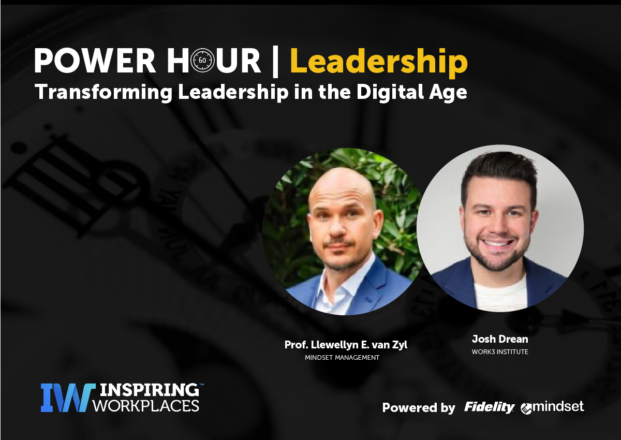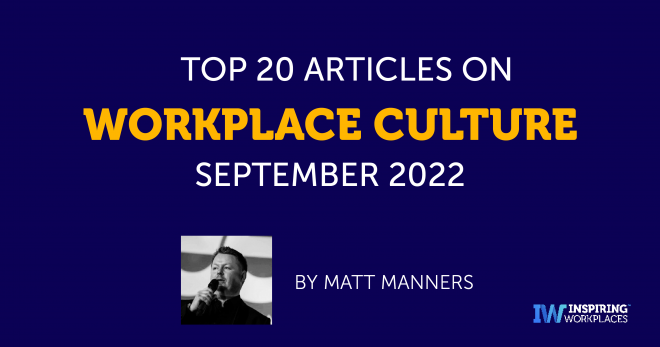
30th September 2024
Top 20 Articles on Workplace Culture: September 2024

Welcome to the Inspiring Workplaces Top 20 Articles on Workplace Culture for September 2024.
We want to help inform and inspire you from some of the best content out there. Each month we will consolidate these articles for you to help give you a quick and easy snapshot. To help drive you and your organisations forward.
The articles will be underpinned by seven key elements that are reflected in our bespoke COMPASS methodology, that also underpin the Top Inspiring Workplaces worldwide. They are:
- Wellbeing
- Culture & Purpose
- Leadership
- Inclusion
- Employee Experience
- Communication & Voice
- Society & Sustainability
Key Workplace Culture Learnings from September:
- Company Culture: Strong organizational culture is key to recruitment, retention, and employee performance, fostering engagement and productivity.
- Amazon’s RTO Mandate: Amazon’s upcoming return-to-office policy raises concerns about its impact on innovation, trust, and employee satisfaction.
- Management Quality: Gallup’s meta-analysis shows that management quality accounts for 70% of team engagement variability, impacting profitability, retention, and customer loyalty.
- Mental Health Disconnect: A study highlights the gap between leadership perceptions and the reality of mental health support, urging better data collection and programs.
- CEO Priorities: UK CEOs focus on growth, AI, ESG, and talent retention, despite economic uncertainty, stressing the importance of resilient strategies and skilled employees.
- Communication Strategies: Leaders must adapt by embracing transparency, active listening, and trust-building to foster loyalty and engagement.
- Long-Term Sickness: Labour’s new policies emphasize mental health and statutory sick pay, placing more responsibility on employers to address absenteeism.
- Career Reflection: After organizational downturns, professionals should assess leadership, personal value, and career opportunities before deciding whether to stay or leave.
- Hybrid Work Challenges: Balancing flexibility with trust and leadership support is key to creating a successful hybrid work culture.
- Wellbeing and Management: Employee wellbeing depends more on effective management practices like clear expectations and goal setting than on work mode.
- Mental Health and DEIB: Aligning mental health and DEIB initiatives boosts employee engagement, well-being, and innovation.
- Green Skills Gap: Rising demand for green talent outpaces supply, urging governments and companies to prioritize workforce development to meet climate goals.
- Psychological Safety: Establishing psychological safety is foundational for genuine workplace inclusion and stronger team engagement.
- Soft Skills Gap: Young professionals struggle with soft skills like communication, which impacts workplace adaptation; education can bridge this gap.
- Holistic Engagement: Moving from traditional surveys to holistic engagement strategies fosters a more dynamic, responsive, and productive workforce.
- Employee Benefits: The demand for financial security, retirement readiness, and healthcare access drives employee retention and engagement.
- Sexual Harassment Prevention: New laws require organizations to proactively prevent harassment through cultural changes and effective training.
- Effective Leadership Communication: Leaders should avoid weak language and adopt assertive communication to boost team motivation and performance.
- Empathy in Leadership: Empathy fosters inclusivity, improves employee relationships, and drives organizational success by valuing diverse perspectives.
- Digital Learning Solutions: Organizations can use digital tools to proactively address workplace issues like harassment prevention and culture building.
The articles are as follows…
Amazon forces RTO 5 days a week—why do companies fear remote work?
Source: Forbes
Author: Rachel Wells
IW COMPASS point: Leadership
Key Takeaways
- Amazon’s RTO Mandate: Amazon will enforce a 5-day return-to-office (RTO) policy starting January 2025, aiming to improve efficiency, collaboration, and innovation.
- Employee Reaction: Many Amazon employees are frustrated with the mandate, expressing a preference for remote work due to its flexibility and productivity benefits.
- Workplace Preferences: Data shows only 2% of workers prefer fully on-site work, with most favoring remote or hybrid models, which they find more productive and satisfying.
- Hybrid Model Advocacy: Experts argue that a hybrid approach balances productivity with in-person collaboration, helping to retain top talent.
- Impact on Employee Satisfaction: Forced office returns may reduce job satisfaction, increase turnover, and hurt work-life balance.
- Potential Motives for RTO:
- Cost-cutting: Amazon may be encouraging voluntary resignations to reduce staff without layoffs.
- Innovation Concerns: Some believe in-person interactions foster innovation, though remote work has also proven effective in this area.
- Company Culture: Fears about remote work eroding corporate culture could be driving the shift.
- Lack of Trust: Persistent concerns that remote work reduces accountability and productivity may also influence RTO decisions.
- Gender Disparity: Remote work is favoured by 71% of employees, with a higher preference among women (73%) compared to men (63%).
- Long-Term Impact: RTO mandates might alienate diverse talent, particularly women, who find remote work crucial for maintaining a balanced professional and personal life.
Read the full article here
World’s Largest Ongoing Study of the Employee Experience
Source: Gallup Workplace
Author: Jim Harter
IW COMPASS point: Employee Experience
Key Takeaways
- Manager Quality is Key: Gallup’s ongoing study shows that 70% of employee engagement variability is due to management quality, directly impacting team performance and retention.
- Employee Engagement Metrics: Gallup’s Q12 survey measures 12 critical workplace experiences such as role clarity, recognition, and purpose, which link to performance outcomes like productivity, customer service, and employee retention.
- Significant Financial Impact: Top-quartile business units achieve 23% higher profits than bottom-quartile units, driven by higher engagement, reduced absenteeism, fewer errors, and increased customer loyalty.
- Meta-Analysis Importance: Meta-analysis combines multiple studies, providing robust conclusions on the relationship between employee engagement and performance across industries, geographies, and time.
- Leadership Challenge: Building a strong culture requires aligning manager-led teams with organizational goals, and Gallup’s research proves that great management drives extraordinary performance.
Read the full article here
Company culture – it’s a feeling thing
Source: IW Guest Post
Author: Richard Roberts
IW COMPASS point: Culture & Purpose
Key Takeaways
- Culture is key: Organizational culture plays a critical role in recruitment, retention, and employee performance, with 77% of job seekers considering it when evaluating companies.
- Connection: Strong interpersonal connections enhance employee well-being and overall perception of the company. Regular in-person interactions and empathetic management foster better relationships.
- Purpose: Employees are increasingly drawn to purpose-driven organizations. Clearly communicating and authentically living the company’s mission boosts engagement and productivity.
- Trust: Trust is a cornerstone of a positive culture. High-trust organizations see higher productivity, less stress, and greater employee engagement.
- Communication: Two-way communication fosters belonging and engagement. Encouraging employee feedback and ensuring inclusivity in messaging is essential.
- Development: Supporting personal and professional growth leads to more engaged, loyal employees. Development initiatives enhance both employee skills and overall well-being.
- People-first culture: Employees need to feel valued, trusted, and developed, reflecting a people-centric culture that positively impacts engagement and retention.
Read the full article here
KPMG 2024 CEO Outlook – UK
Source: KPMG
Author: KPMG
IW COMPASS point: Leadership
Key Takeaways
- Growth Prospects: UK CEOs are confident about growth but feel pressure from economic uncertainty, AI integration, and geopolitical complexities.
- Top Risks: Cybersecurity and supply chain risks are top concerns over the next three years.
- Operational Priorities: Advancing digitization and attracting top talent are key to driving business growth.
- Generative AI: AI is a top investment, with CEOs recognizing its potential for upskilling and productivity gains.
- Talent Challenges: 63% of CEOs believe lacking the right talent will negatively impact growth, emphasizing the importance of lifelong learning.
- Return to Office: 83% of UK CEOs expect a full return to office within three years, despite employee preference for flexibility.
- ESG Importance: CEOs acknowledge ESG as key for competitive edge, but only 55% are confident in hitting net zero by 2030.
- Sustainability ROI: 86% of CEOs expect to see significant returns on sustainability investments after three years.
Read the full article here
Bosses blind to mental health crisis as absenteeism soars
Source: HR Grapevine
Author: Liam Soutar
IW COMPASS point: Wellbeing
Key Takeaways
- Perception vs. Reality: 73% of business leaders believe they are well-prepared for mental health concerns, but less than half collect comprehensive data on mental health conditions, leading to gaps in understanding.
- Rising Absenteeism: 64% of businesses report increased absenteeism due to mental health issues, yet only 41% have increased mental health spending, and 28% have boosted training.
- Younger Workers Most Affected: Mental health services are most utilized by employees aged 25-34, with 51% of business leaders seeing significant impact in this age group.
- Data Gaps: Less than half of businesses track conditions like anxiety (44%), depression (44%), or stress (46%), limiting their ability to provide effective support.
- Neglecting Neurodiversity: Many leaders are unaware of cognitive conditions and neurodiversity in their workforce, with 38% reporting no incidences of conditions like dementia or Alzheimer’s.
- Importance of Mental Health Support: Businesses that fail to track mental health risk increased absenteeism, lower morale, and reduced productivity, emphasizing the need for better mental health support programs.
- Strategic Priorities: 40% of businesses aim to strengthen mental health support, with initiatives like phased returns to work (34%) and flexible working arrangements (31%) becoming common strategies.
- Need for Robust Data Collection: Accurate data on mental health conditions is critical for developing effective support systems and improving employee wellbeing long-term.
- Call for Government Action: Employers are relying on private insurance to cover mental health gaps in the NHS. The government could help through tax rebates and incentivizing research in mental health support.
Read the full article here
5 Business Audiobooks to Refresh Your Leadership Skills
Source: IW Guest Post
Author: Rita Jolene
IW COMPASS point:
Key Takeaways
- Lifelong learning is essential for adapting to the evolving business landscape.
- Reading business books by industry experts provides valuable knowledge, wisdom, and practical advice.
- Ray Titus, CEO of United Franchise Group, recommends asking for book suggestions, setting reading goals, and dedicating an hour weekly to business books.
- Audiobooks offer a convenient alternative for busy leaders, enabling learning while multitasking.
- Subscription-based digital libraries provide easy access to a vast collection of business audiobooks.
- Recommended leadership audiobooks include:
- The Strategist by Cynthia Montgomery: Focuses on developing strategic leadership skills.
- Think Faster, Talk Smarter by Matt Abrahams: Offers tips on navigating spontaneous communication situations.
- Dare to Lead by Brené Brown: Encourages leaders to embrace vulnerability and empathetic communication.
- The Emotionally Intelligent Leader by Daniel Goleman: Highlights the role of emotional intelligence in leadership.
- Developing the Leader Within You 2.0 by John Maxwell: Focuses on self-discipline and making impactful changes in leadership.
Read the full article here
How leaders can effectively communicate in today’s workplace
Source: Forbes
Author: Cynthia Pong, JD
IW COMPASS point: Communication
Key Takeaways
- Shift in Workplace Social Contract: The traditional contract of job security in exchange for loyalty has been disrupted, requiring new leadership communication strategies.
- Embrace Transparency: Leaders must practice clear, honest communication, especially during times of uncertainty, to rebuild trust and engagement.
- Active Listening and Empathy: Providing employees with space to voice concerns and acknowledging their experiences fosters trust and shows care.
- Build Trust with Consistent Action: Actions must back up words; leaders need to follow through on commitments to restore trust.
- New Leadership Challenges: Effective communication is crucial in navigating today’s workplace, requiring continuous adaptation, transparency, and empathy to maintain engagement.
Read the full article here
Prioritising mental health in the workplace
Source: People Management
Author: Crowley Woodford
IW COMPASS point: Wellbeing
Key Takeaways
- Rising long-term sickness: Mental health issues are the leading cause of long-term sickness absence, accounting for 44% of cases, affecting productivity.
- Economic impact: Long-term sickness absences could cost the UK economy £66.3bn annually by 2030 due to lost productivity.
- Legal obligations: Employers must consider disability discrimination laws and make reasonable adjustments for employees with serious long-term conditions.
- Stress as a precursor: Stress, though not a legal disability, often leads to other conditions like depression, raising risks for employers.
- Labour’s proposals: The government plans to strengthen statutory sick pay, remove waiting periods, and review health and safety guidelines.
- Mental health monitoring: Employers may face increased responsibility in monitoring and managing employees’ mental health under new proposals.
- Challenges for employers: While reforms aim to prioritize health, without adequate public health support, businesses may face increased costs and burden.
Read the full article here
Four ways to know whether to stay or go if your workplace is a sinking ship
Source: The Conversation
Author: Prof. Sir Cary Cooper
IW COMPASS point: Employee Experience
Key Takeaways
- Assess Leadership Changes: Consider whether new leadership will be more resilient and successful, as it may impact your decision to stay or leave.
- Evaluate Your Value: Determine if the new management values your contributions and if staying could offer more long-term opportunities.
- Personal Brand Impact: Reflect on whether association with a failing organization has damaged your personal brand, which could make finding a new job more difficult.
- Opportunity for Change: Consider if this is a chance to pursue a different career path or sector based on your skill set.
- Control Over Career Path: Change can be positive if it’s not forced; explore career options that align with your strengths, weaknesses, and future aspirations.
- Purpose in New Role: Ensure any new role aligns with your skill set, workload preferences, and offers a sense of accomplishment and success.
Read the full article here
Hybrid working: Creating new, high-trust workplace cultures
Source: Relocate Global
Author: Marianne Curphey
IW COMPASS point: Culture & Purpose
Key Takeaways
- Hybrid working brings both opportunities and challenges: While it offers efficiency and cost savings, creating a high-trust workplace culture that aligns with business goals can be difficult.
- Return-to-office (RTO) mandates are a source of conflict: According to Gartner, 74% of HR leaders cite RTO mandates as contentious, especially among high performers, women, and millennials who value flexibility.
- Balancing efficiency and effectiveness: Jonathan Evans emphasizes the need for clear communication of business objectives to ensure that remote work is not only efficient but also effective.
- Supportive workplace culture is essential: In-person interactions help younger employees with mentorship, while a culture that values wellbeing and development is crucial for aligning personal growth with organizational goals.
- Job crafting enhances employee engagement: Dr. Esther Canonico highlights that giving employees autonomy in shaping their roles increases satisfaction, motivation, and productivity.
- Trust is key to hybrid work success: Dr. John Blakey stresses the importance of building a results-oriented work environment (ROWE) and fostering trust, rather than relying on traditional leadership styles.
- Flexibility is vital for productivity: Liz Sebag-Montefiore discusses how flexibility in work schedules and environments positively impacts motivation, work-life balance, and productivity.
- Hybrid work attracts top talent: Jean Bays points out that hybrid models are critical for retaining younger generations, promoting diversity, and breaking down geographical barriers.
- Hybrid work is the future: The article concludes that hybrid work environments, which support employee success and align with organizational goals, will be crucial for staying competitive.
Read the full article here
Employee wellbeing hinges on management, not work mode
Source: Gallup Workplace
Author: Andy Kemp
IW COMPASS point: Wellbeing
Key Takeaways
- Management, Not Work Mode, Drives Wellbeing: Employee wellbeing is more influenced by management practices than whether they work remotely, hybrid, or on-site.
- Work-Life Balance Insights: While remote work can improve work-life balance, the benefits are not guaranteed without effective management.
- Clear Expectations Matter: Employees who know what’s expected of them are less likely to experience burnout and work-life balance struggles.
- Collaborative Goal Setting: Managers should involve employees in setting realistic performance goals to prevent burnout and maintain balance.
- Recognition Enhances Wellbeing: Recognizing employees’ achievements, especially outside of work, reinforces that the organization values their wellbeing.
- Focus on Human-Centric Practices: Clear expectations, goal setting, and strategic recognition are key strategies to enhance wellbeing across all work modes.
Read the full article here
New data highlight connection between mental health and DEIB initiatives
Source: Business Wire
Author: One Mind at Work
IW COMPASS point: Inclusion
Key Takeaways
- Connection Between Mental Health and DEIB: Aligning mental health and DEIB (Diversity, Equity, Inclusion, and Belonging) initiatives leads to improved employee engagement and organizational performance.
- Siloed Efforts: Less than one-third (28%) of organizations align their mental health and DEIB strategies, leading to missed opportunities.
- Unmet Diverse Workforce Needs: Fewer than half (48%) of organizations offer culturally appropriate mental health resources, and many providers lack cultural competency training.
- Impact of Alignment: Organizations that align mental health and DEIB efforts report 25% higher employee engagement and 40% higher program maturity.
- Call to Action: Employers are encouraged to integrate mental health and DEIB initiatives to foster employee well-being, improve retention, and drive innovation.
- Future Benefits: Aligned strategies lead to higher innovation, team cohesiveness, and stronger connections with diverse customer bases.
- Mental Health at Work Index: A self-assessment tool helping organizations measure and improve the maturity of their mental health programs.
Read the full article here
LinkedIn warns of looming green skills gap as demand skyrockets
Source: edie
Author: Sidhi Mittal
IW COMPASS point: Society & Sustainability
Key Takeaways:
- Demand for Green Skills Outpaces Supply: Global demand for green skills grew by 11.6%, while supply increased by only 5.6%, leading to a widening skills gap projected to reach 101.5% by 2050.
- Countries Leading Green Talent Demand: The UK (13%), Ireland (12.4%), Saudi Arabia (11.7%), and Norway (11.6%) are at the forefront of green job roles requiring specific skills.
- Surging Green Job Demand: Countries like Portugal saw a 71.3% increase in demand for green skills, while the UK saw a 46% rise.
- Green Talent Hiring Rates Soaring: Green talent is being hired at significantly higher rates than other sectors globally, with a hiring rate 54.6% higher for green jobs.
- Need for Government Action: LinkedIn stresses the need for governments to incorporate green skills development into climate strategies and calls for a formal COP29 declaration to expand the global green workforce.
- Lack of Soft Skills in Sustainability: A study reveals that sustainability professionals lack soft skills training, which is critical for teamwork, empowering others, and managing organizational change.
- Emotional Strain on Sustainability Professionals: The study found that sustainability roles are emotionally taxing, highlighting the need for better support and training in soft skills to foster climate leadership.
Read the full article here
Your inclusion efforts are failing – this is why
Source: People Management
Authors: Gina Battye
IW COMPASS point: Inclusion
Key Takeaways
- Misunderstanding of psychological safety and inclusion: Psychological safety and inclusion are often mistakenly seen as intrinsically linked. However, psychological safety must be established first for true inclusion to take root.
- Psychological safety as a foundation for inclusion: Inclusion without psychological safety remains superficial, as individuals may participate but not engage fully or authentically. Psychological safety enables deeper involvement and authentic contributions.
- Psychological safety defined: It is the individual’s sense of safety, comfort, and confidence within a specific context, and it is essential for people to express their true selves.
- Hierarchy of psychological safety: Organisations should build psychological safety at eight levels, starting from individual safety to global safety. Focusing only on organisational safety (Level 5) without addressing individual, interpersonal, and team safety (Levels 1-4) undermines inclusion efforts.
- Common organisational mistake: Many organisations focus on organisational inclusion without first establishing psychological safety at the foundational levels. This lack of groundwork leads to superficial inclusion efforts.
- Genuine inclusion requires psychological safety: True inclusion is not just about participation or representation; it’s about creating a space where people feel safe and empowered to contribute authentically.
- The role of psychological safety in EDI initiatives: Building psychological safety at all levels boosts employee well-being, engagement, and performance, driving the success of Equity, Diversity, and Inclusion (EDI) initiatives.
- Path to true inclusion: Organisations must shift their focus toward psychological safety as a continuous commitment, ensuring inclusion becomes a core part of the organisational culture rather than a mere initiative.
Read the full article here
Young professionals are struggling to socially adapt in the workplace – educators can help
Source: The Conversation
Author: Lee Ann Rawlins Williams
IW COMPASS point: Communication
Key Takeaways
- Increasing value of soft skills: Employers increasingly prioritize soft skills, such as communication, conflict resolution, and emotional intelligence, which are often underemphasized in traditional higher education.
- Disconnect between education and workplace readiness: Colleges focus on academic expertise but frequently fail to prepare students for the social and emotional demands of the workplace, creating challenges for young professionals.
- Challenges faced by new graduates: Young professionals, like the case of “Emily,” struggle with workplace culture, communication, feedback management, and handling conflict, which can lead to stress, anxiety, and job performance issues.
- Generational communication divide: Differences in communication preferences between younger workers (favoring digital communication) and older colleagues (preferring direct, in-person interactions) contribute to workplace misunderstandings.
- Need for workplace preparation in higher education: There is a missed opportunity in higher education to continue the development of emotional and social skills that begins in K-12 schooling.
- Proposed solutions for educators:
- Implement role-playing simulations to teach interpersonal and conflict management skills.
- Create “feedback loops” for practicing constructive feedback and emotional resilience.
- Offer leadership courses focused on emotional intelligence, empathy, and adaptability.
- Include mental health and resilience training in curricula to equip students for job-related stress.
- Bridging the gap: By teaching emotional intelligence, communication skills, and adaptability, educators can better prepare students for the challenges of transitioning from school to the workplace.
Read the full article here
Engagement essentials: Addressing the three biggest mistakes organizations make
Source: IW Guest Post | Mindset
Author: Dr Clif P Lewis
IW COMPASS point: Employee Experience
Key Takeaways
- Limitations of traditional engagement surveys: Conventional, standardized engagement surveys often fail to capture the personal, lived experiences of employees, resulting in outdated, impersonal data that hinders effective organizational improvement.
- Reactive vs. proactive engagement: Traditional surveys provide only snapshots of employee experiences, leading to reactive engagement efforts that overlook critical individual insights necessary for tailored interventions.
- Holistic engagement: A decentralized approach that integrates organizational, managerial, and individual levels to create personalized, dynamic engagement strategies responsive to real-time employee needs.
- Step 1: Creating an engaging environment: Identify and address factors that inhibit engagement while promoting those that drive it, fostering a positive workplace culture.
- Step 2: Empowering managers and leaders: Equip managers with skills, resources, and actionable insights to effectively drive team engagement beyond generic training methods.
- Step 3: Driving individual engagement: Empower employees with tools and autonomy to actively engage in shaping their own experiences within the organization.
- Decentralization of engagement: Engagement responsibility is distributed across the organization, shifting from a top-down HR approach to a shared responsibility model involving real-time analytics and personalized feedback.
- Dynamic and personal engagement: The holistic approach provides a more responsive, individualized platform for engagement, making employees feel valued and motivated, which boosts overall productivity.
- Conclusion: Mindset’s holistic engagement model encourages HR and OD practitioners to adopt decentralized strategies that personalize engagement efforts across the entire workforce.
Read the full article here
Understanding the employee voice
Source: WTW
Author: WTW
IW COMPASS point: Employee Voice
Key Takeaways
- Financial concerns: Three in ten workers face financial challenges, and nearly nine in ten in the U.S. worry about affording basic necessities.
- Retirement insecurity: 75% of employees are not saving enough for retirement, and many expect to work beyond age 70.
- Mental health struggles: Despite post-pandemic improvements, half of younger workers still show signs of anxiety and depression.
- Healthcare access: Four in ten employees express concerns about lengthening wait times for healthcare.
- Growing desire for security: Pay remains a top priority, but benefits are increasingly important for both attraction and retention, with a 50% rise in the importance of benefits since 2017.
- Increased demand for remote work: Employees’ desire to work remotely has doubled, and unmet flexibility needs lead to disengagement and job-seeking.
- Rising appreciation for benefits: Employee satisfaction with benefits has increased by 15-45% since 2017, thanks to greater choice and virtual care options.
- DEI progress: Nearly 50% of employees believe their employer has made significant progress in diversity, equity, and inclusion (DEI) initiatives.
- Employee needs vs. employer priorities: Employees prioritize financial wellbeing and work flexibility far more than employers do, creating a gap in expectations.
- Simple solutions: Employers can improve wellbeing by encouraging free time, exercise, and providing financial education to help employees make better choices. Social support through teams and managers is key to driving change.
Read the full article here
How prepared are you for the legal changes coming on sexual harassment in the workplace?
Source: HR Magazine
Author: Shirley Berry
IW COMPASS point: Employee Experience
Key Takeaways
- New legal requirements: Organizations in England, Wales, and Scotland must shift focus from managing complaints to preventing workplace sexual harassment under new laws effective from October 27.
- Importance of proactive measures: Companies will need to demonstrate efforts to change organizational behaviors and prevent incidents, rather than just responding to reports of misconduct.
- High risk of unreported harassment: Statistics show a significant portion of sexual harassment goes unreported, meaning companies need to take proactive steps to address potential issues before they arise.
- Worker Protection Act enforcement: The Equalities and Human Rights Commission (EHRC) will enforce the new regulations, and failure to take “reasonable steps” could lead to increased compensation for victims in employment tribunals.
- Building a positive culture: Organizations must embed a welcoming and safe culture for all employees by clearly communicating behavioral expectations and ensuring effective reporting and response mechanisms.
- Training and e-learning solutions: Digital learning resources, such as Me Learning’s “Preventing Sexual Harassment in the Workplace” package, offer scalable and engaging training options to promote culture change and ensure compliance.
- Engaging and interactive learning: E-learning programs offer interactive modules, bite-sized learning, and scenario-based training to promote understanding and retention of knowledge on sensitive topics like sexual harassment.
- Tailored learning programs: Companies can customize e-learning packages to reflect specific industry or organizational needs, with examples from sectors like healthcare, sports, and finance.
- Ongoing training reinforcement: Continuous learning interventions ensure better knowledge retention, helping organizations create lasting cultural changes and reduce risks of workplace harassment.
- Act now: Organizations are encouraged to adopt these preventative measures immediately to ensure compliance with upcoming legal changes and create safer, more productive workplaces.
Read the full article here
6 negative phrases leaders use that demotivate teams
Source: Forbes
Author: Dr. Cheryl Robinson
IW COMPASS point: Communication | Leadership
Key Takeaways
- Importance of clear communication: Leaders must be self-aware of their language as it shapes team perception and impacts collaboration, productivity, and morale.
- The weight of words: Positive and assertive language enhances a leader’s perceived competence, while weak or uncertain language undermines credibility and authority.
- Phrases to avoid:
- “I think” or “I believe” – Signals indecisiveness and lack of conviction.
- “I’ll try” – Suggests lack of commitment and demotivates the team.
- “That’s not my job” – Shows unwillingness to take responsibility, hindering collaboration.
- “I’m not sure” – Expresses uncertainty, damaging credibility.
- “We’ve always done it this way” – Reflects resistance to change and innovation.
- Alternative phrases to use:
- Use “I’m confident” or “I know” to convey certainty and decisiveness.
- Replace “I’ll try” with “I will” to demonstrate commitment.
- Swap “That’s not my job” with “I’ll handle this” to foster ownership and teamwork.
- Instead of “I’m not sure”, say “Based on my experience” or “The data suggests” to express informed opinions.
- Use “Let’s explore new possibilities” rather than “We’ve always done it this way” to encourage innovation.
- Developing self-awareness: Regular self-reflection, feedback from peers, and reviewing recorded meetings help identify weak language patterns.
- Improving communication skills: Role-playing, affirmations, and attending professional development workshops are key techniques to practice assertive and effective communication.
- Conclusion: Intentional and assertive communication can significantly improve leadership effectiveness and team performance.
Read the full article here
Inclusion starts with empathy
Source: HR Zone
Author: Jack Mizel
IW COMPASS point: Inclusion
Key Takeaways
- Empathy as a foundation: Empathy is the key to building an inclusive organization by seeing others’ needs as important as your own and acting on them.
- Balance in leadership: Leaders must balance organizational priorities with individual needs to foster better relationships and a more engaged workforce.
- Inclusive culture: Valuing diverse perspectives and embracing differences such as race, gender, ability, and culture creates a sense of belonging and leads to higher performance.
- Importance of soft skills: Active listening is essential to understanding and empathizing with employees, helping leaders uncover what truly motivates their teams.
- Inclusion ethos: Instead of calling people out, focus on inviting them in, acknowledging their strengths, and helping them improve while fostering a sense of inclusion.
- Impact of empathy: Demonstrating empathy through active listening leads to better understanding, improved employee engagement, and more productive working relationships.
- Ask more questions: Taking a few extra minutes to ask questions and genuinely listen when delegating tasks can significantly improve outcomes and relationships.
Read the full article here.







